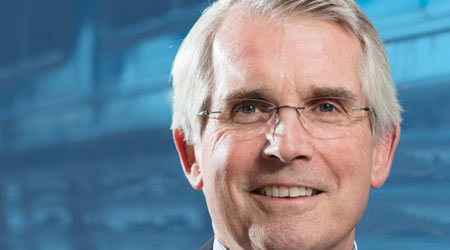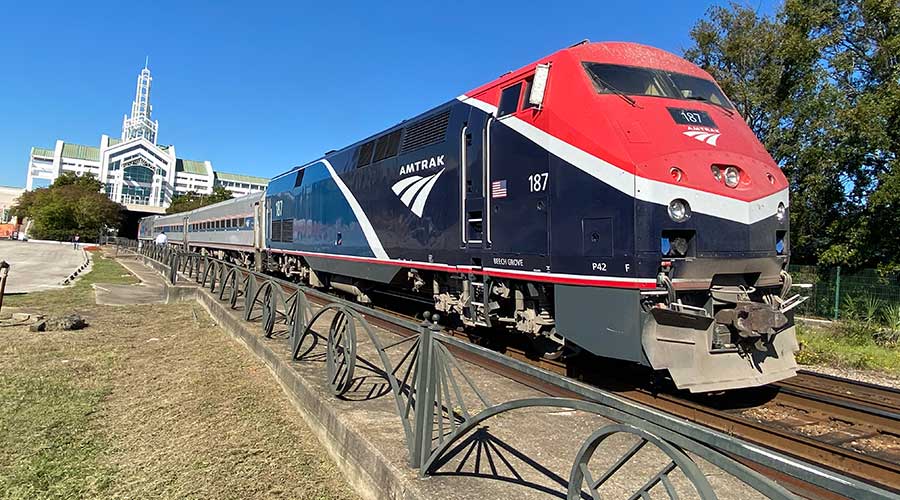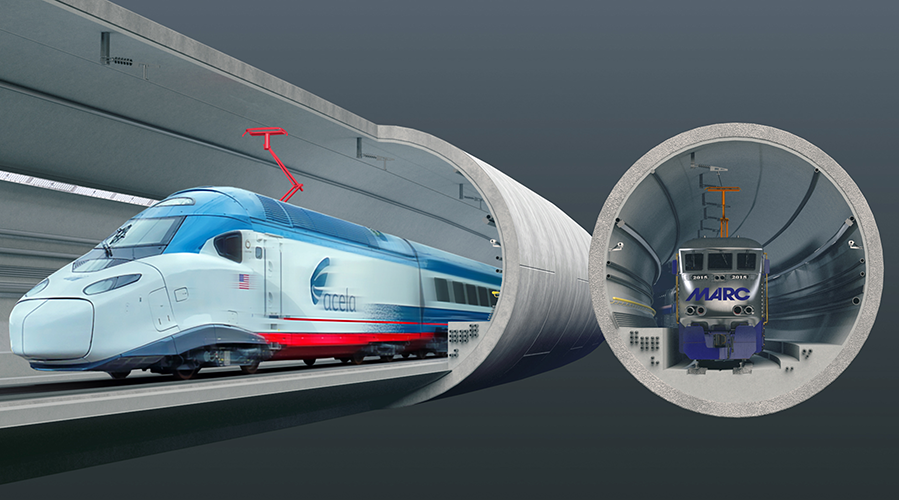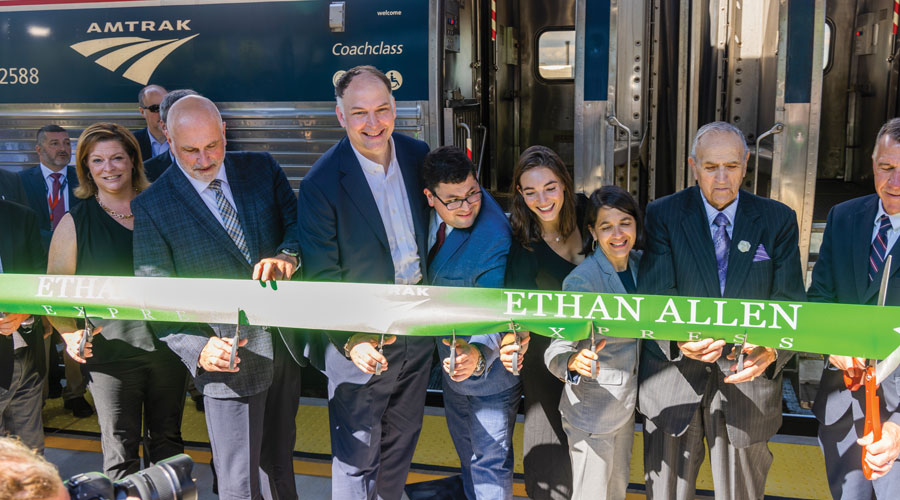Stay updated on news, articles and information for the rail industry
December 2016
Rail News: Amtrak
What's Next for Wick Moorman and Amtrak?

By Julie Sneider, senior associate editor
To start, some big projects and high-speed trains
When Amtrak Chairman Anthony Coscia learned last year that Joseph Boardman planned to retire as the railroad's president and chief executive officer this fall, one of the first people Coscia thought of as a potential successor was Charles "Wick" Moorman.
Coscia was well aware of Moorman's reputation as a rail industry leader during his tenure at Norfolk Southern Corp., where Moorman was chairman, president and CEO until his retirement last year. But also, their paths had crossed a few times during Coscia's eight-year term as chairman of the Port Authority of New York and New Jersey, which is served by NS.
Coscia believed early on in the search process that Moorman would be the "ideal" choice to guide the national intercity passenger railroad into the future. The board believed that Amtrak was already a "great company" with a lot of potential, given its longtime status as an undercapitalized institution.
Rather than simply "sharpening our lobbying effort" to hit up Congress for a larger appropriation, Coscia says, the board thought it would be better to spend more time convincing stakeholders that the railroad serves the public well with the limited resources that it has.
"No one invests in a company that isn't well run," Coscia says. "And our feeling was that a lot of progress had been made at Amtrak under Joe Boardman's tenure, and [his retirement] was an opportunity to build on that and create a very, very well-run company."
Coscia thought Moorman would be the executive to guide Amtrak to that next level of performance.
"He was one of the first people I talked to because he encountered very similar challenges in the freight-rail industry, went through the transition and navigated that extraordinarily well," Coscia explains. "We thought that same kind of 'best-in-class' mentality brought to passenger rail would make us as strong as possible."
Moorman retired after serving NS and its predecessor Southern Railway for more than 40 years, rising from management trainee to the company's top post. In 2006, he was named NS chairman, president and CEO. He's a graduate of Georgia Institute of Technology, where he majored in civil engineering, and Harvard Business School, where he earned an MBA.
In 2013, Moorman received Progressive Railroading’s "Railroad Innovator Award" in recognition of his achievements in the rail industry, which included overseeing the rapid infusion of new technology in railroad operations, major investment in strategic rail corridors and intermodal business, and development of a safety culture that emphasizes positive reinforcement to promote proper practices at NS. He also found ways to diversify the railroad business and remain profitable in a post-coal era.
When NS named its largest classification yard — a Bellevue, Ohio, yard — after Moorman last year, current NS President and CEO James Squires described him as a "railroader who thinks big, who thinks long term, and who does the right things in the right ways."
Goal: a well-run railroad
Of course, Amtrak will never clear the kind of profit Class Is make, but that's not what the Amtrak board was looking for in its next top executive, says Coscia.
"This is not about being profitable, it's about being well run," he says. "It's about using our resources wisely, and looking for creative and intelligent ways to run the company — and Wick did all those things at Norfolk Southern. He attacked the issues of safety, of customer service and financial performance because no one is comfortable putting more money into something they don’t believe is being run as well as it should be."
When first approached about the Amtrak post, Moorman declined to be considered.
"I was enjoying retirement, which, quite frankly, is a really good gig," Moorman says with a chuckle. "But I told [Coscia] I would be willing to help wherever I could, because I do believe that Amtrak is a very important institution."
Months later, Coscia came calling again. This time, he approached Moorman with the idea that the job would not be long term, but a commitment to steer Amtrak through some major projects and help build a management team for the railroad’s future.
This time, Moorman accepted.
"I have a long history in the railroad business, and the railroad business has been very good to me," he says. "So when I was approached again and asked to help set the stage for the right long-term person to come in, I decided that I had a good background to do that, and that it would be in some shape or form a public service."
Moorman doesn't know exactly how long his stay at Amtrak will last. Still, he'll be there long enough to tackle some key issues necessary to make the organization function more effectively.
"I think we need to continue — and there has been progress at Amtrak — to really focus on building a strong culture centered around safety first, and then on customer service," he says.
Railroad safety culture
Amtrak's safety record has been in the spotlight since the May 2015 derailment in Philadelphia that killed eight passengers, and an April train accident in Chester, Pa., that killed two Amtrak maintenance-of-way workers. In Philadelphia, the National Transportation Safety Board (NTSB) determined the derailment occurred after the train engineer became distracted and sped into a curve. The lack of an operating positive train control (PTC) system on the section of track where the train derailed was a factor in the crash, according to the NTSB.
Although the safety board has not yet issued its final report on the April incident, a preliminary report noted that it occurred when Amtrak Train 89 struck a backhoe performing MOW work, killing the backhoe operator and a supervisor. The train had seven crew members and 337 passengers on board. Forty-one people were taken to local hospitals.
"We think it's important that Wick build the kind of safety culture at
Amtrak that he also built at Norfolk Southern," Coscia says.
Moorman acknowledges Amtrak is "not at the place that the Class I carriers are in terms of a safety record and safety culture."
On the PTC front, the Northeast Corridor is now equipped with the ACSES system, but still remaining is installation of the I-ETMS technology on diesel locomotives on Amtrak’s state-supported long-distance routes that run on Class I lines. Amtrak will have that effort completed by the time freight railroads have their PTC systems operational, Moorman says.
Developing a strong safety culture is one side of a more efficient railroad. Another is stability in the railroad’s finances. And on that point, Amtrak made some inroads this past year: It broke ticket revenue and ridership records, and posted its lowest operating loss ever in fiscal-year 2016, according to unaudited results released last month.
Fueled by a record 31.3 million passengers, Amtrak logged a record $2.14 billion in ticket revenue in FY2016, which was $12 million greater than in FY2015. The latest fiscal year, which ended Sept. 30, was the sixth consecutive year that annual ridership exceeded 30 million passengers.
Total revenue reached a record $3.2 billion. The railroad posted an operating loss of $227 million, down $78 million from FY2015, and the lowest operating loss since 1973. Moreover, Amtrak covered 94 percent of operating costs with ticket sales and other revenue, up from 92 percent in FY2015. And it made a net reduction in long-term debt of $71.4 million.
"We had another very good year in terms of ridership and revenue," says Moorman. "Our expense control was very good, so we will have a continuing positive story to tell."
But few passenger railroads in the world make a profit, Moorman adds. So while Amtrak continues to drive down its operating deficit, it can't "economize" to a point of hurting the quality of the product, he says.
"One of the things we're going to pay a lot of attention to going forward is the customer experience," he continues. "We'll balance the customer service needs with our ability to be more efficient and effective, particularly in those areas that don't directly affect the customer."
Capital investment also will be emphasized. The FAST Act adopted by Congress last year included for the first time a passenger-rail title in a long-term surface transportation funding bill. While the new provision requires Amtrak to indicate to Congress how the $8 billion in funding should be allocated between the Northeast Corridor and the railroad’s national network, the provision does not determine whether the federal funds should go toward operating loss or capital, Moorman notes.
"So, it's our intention to try to invest in as much capital as we can and hold the operating losses down," he says. "That creates a new paradigm for how Amtrak thinks about the money we spend."
Managing big rail projects
And when it comes to capital investments, Amtrak has two major ones in its immediate future: the $20 billion "Gateway" program for the Northeast Corridor, which includes replacing the 106-year-old Hudson River rail tunnels between New York and New Jersey; and the recently announced $2.45 billion plan to acquire 28 next-generation high-speed trains for the Acela Express service on the corridor.
With the Gateway and Acela Express programs underway, Amtrak needed an executive leader with the experience to manage capital projects of such magnitude, according to Coscia.
"Forty years of under-investment in passenger rail has created some glaring things that need to be built, both in infrastructure and in rolling stock," he says. "Getting the money is difficult; almost equally difficult is overseeing and managing the project so that it’s delivered on time and on budget."
Amtrak has never had to build an organization like that. Now that it does, Moorman will be "an ideal architect for building capacity to manage large-scale and even smaller-scale capital projects" efficiently, Coscia adds.
Furthermore, the board is looking to Moorman to recruit other executives to help Amtrak move forward. He’s already begun doing so: Moorman has talked with former NS executives who retired about the time he did to help do a "deep dive" into critical areas where Amtrak needs improvement. One executive already tapped to help is former NS Executive Vice President and Chief Operating Officer Mark Manion, although Moorman didn't offer details on what Manion's focus will be.
Mending fences
Another area where Moorman believes he can make a difference is in Amtrak's relationships with the Class Is. Those connections have been strained as of late, in part because of some cases before the Surface Transportation Board involving on-time performance and regulatory authority for Amtrak trains operating on freight railroads' tracks for national network routes.
"The relationships with the Class Is are not terrible by any means. I think we can work through a lot of the issues around things like on-time performance," Moorman says, adding that it's to each side’s advantage to promote what’s in the best interests for rail — passenger and freight.
"We need to make sure the Class Is see us an ally in creating a positive public image; in working on issues that are important to both of us on Capitol Hill; and as a card-carrying member of the railroad industry," he says.
Presenting a unified rail front will be crucial for the industry when a new Congress and administration take office in January. During the campaign, President-elect Donald Trump pledged to invest heavily in revamping the nation’s infrastructure. The Association of American Railroads and American Public Transportation Association officials already have said they want to be part of any proposal the Trump administration puts forth.
"What we need to do at Amtrak is make sure that we are running an efficient company that provides a great product to the 30-plus million people who use our services every year," says Moorman. "If we do that, I think we should be able to answer effectively to anyone on Capitol Hill — or anyone else — who has criticisms about us."
Moorman, who up until Oct. 1 had spent his entire career on the freight side of the railroad business, has an optimistic outlook for passenger rail in the United States.
"Part of what brought me here is that the general public's desire for more effective passenger-rail transportation has grown enormously over the past 10 years," says Moorman, who rides the train from his home in Charlottesville, Va., to Amtrak's offices in Washington, D.C.
That public interest in rail will continue to expand — primarily on the state routes, Moorman believes.
"I think there will be a ton of opportunity to continue to come our way as the years go by, and we at Amtrak need to be a company that understands that, is prepared for it, and operates that service effectively with our state partners," he says.
Email comments or questions to julie.sneider@tradepress.com.


 2025 MOW Spending Report: Passenger-rail programs
2025 MOW Spending Report: Passenger-rail programs
 Gardner steps down as Amtrak CEO
Gardner steps down as Amtrak CEO
 Guest comment: Oliver Wyman’s David Hunt
Guest comment: Oliver Wyman’s David Hunt
 Women of Influence in Rail eBook
Women of Influence in Rail eBook
 railPrime
railPrime







